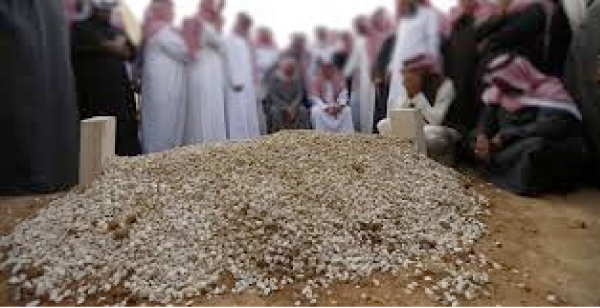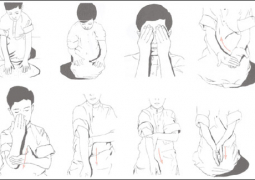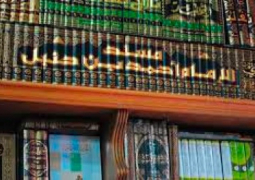
A Lahd is better than an Ordinary Grave
Lahd is a crevice on the side of a grave facing the qiblah, which is covered with unburnt bricks like a house with a roof. A regular grave, on the other hand, is a pit dug in the ground, with the body placed in it and then sealed off with unburnt bricks and covered to form a ceiling. Either of these two methods is permissible, but the first one--lahd--is preferable in the light of a hadith reported by Ahmad and Ibn Majah on the authority of Anas who said: “When the Prophet, peace be upon him, died, there were two grave diggers. One usually dug the lahd and the other a regular tomb-like grave. The Companions said: ‘Let us seek guidance from our Lord.’ Then they asked each of them to dig a grave, and decided the grave of the one who finished first be chosen for the burial of the Prophet’s remains. The one who dug the lahd finished first, so they buried the remains of the Prophet, peace be upon him, in a lahd.” This hadith shows that both forms are permissible. The fact that the lahd is preferable is indicated by a tradition transmitted by Ahmad and the Compilers of the Sunan on the authority of Ibn ‘Abbas who reported: “The Prophet, peace be upon him, said: ‘Lahd is for us, and digging a pit (i.e., a regular grave) for others.”’
Placing a Body in the Grave
It is Sunnah to place a body in the grave with its feet first, if this is possible and can be done easily. This is based on a hadith reported by Abu Daw’ud, Ibn Abi Shaibah, and Al-Baihaqi that Abdallah ibn Zaid placed a body with its feet first in the grave and said, “This is sunnah.” If this is not easy, then a body could be placed in the grave in any manner possible. Ibn Hazm said: “A body may be placed in the grave in any manner possible, from the direction of the qihlah, or from a direction opposite to it, with its head first, or with its feet first, for there is no explicit instruction regarding this in the texts.” An-Nawawi said: “You should know that the right manner of accompanying a funeral procession is to remain quiet, as the pious among the previous generations of Muslims did. One should not raise one’s voice for recitation or for the remembrance of Allah, or for anything else. Keeping quiet is better and is helpful in concentrating one’s attention on the funeral rites, which is needed at that time. This is the correct position, and the fact that a large number of people do otherwise does not change it. There is a consensus among scholars that the way ignorant people recite in the funeral processions, artificially prolonging sounds of various words and mixing them up, is forbidden.
Placing the Body Facing the Qiblah, Praying for the Deceased, and Loosening the Shroud
The practice of the learned ones has been to place the body on its right side facing the qiblah. The person placing the body in the grave should say: “In the Name of Allah, and in accordance with the tradition of Allah’s Messenger, peace be upon him.” Then he should loosen the shroud. Ibn ‘ Umar reported that when a body was placed in the grave, the Prophet, peace be upon him, used to say: Bismillah wa ‘ala sunnat rasulillah. “In the name of Allah, and in accordance with the tradition of Allah’s Messenger or the practice of Allah’s Messenger.” (Reported by Ahmad, Abu Daw’ud, Tirmizhi, Ibn Majab and Nasa’i, who transmitted it both as a mauquf hadith (its chain of transmitters stopping at a Companion), and as a musnad (uninterruptedly from the Prophet himself)).
Placing Clothes in the Grave is Disliked
The majority of jurists dislike the idea of placing a garment, a pillow, or the like for the deceased in the grave. Ibn Hazm, however, sees nothing wrong in placing a piece of garment under the body in the grave, in light of a hadith reported by Muslim from Ibn ‘Abbas who said: “A red piece of cloth was placed in the grave of the Prophet, peace be upon him.” Ibn Hazm says apparently it was Allah’s Will to permit them to do so, because His Prophet, the innocent and guiltless, and others who practiced it were, according to the consensus, indeed the best of men, and none of them ever objected to it.” The scholars consider it desirable, however, for the head of the deceased to be placed on a brick, a stone, or on the ground with his right cheek on a brick or some other similar thing, and with his shroud removed from his face so that his left cheek is open to the soil. ‘Umar advised his heirs: “After having placed my body in the grave, leave my cheek open to the soil.” Similarly Ad-Dahak in his will gave instructions that his shroud should be untied and his cheek exposed. It is preferred if something, some bricks or stones or soil, is placed to support the body so as not to leave it flat on its back. Abu Hanifah, Malik, and Ahmad hold that a piece of cloth may be spread over a female body, but not over a male body, when lowering it into the grave. The Shafi’i school, however, is of the opinion that doing so is desirable for both male and female.
Throwing Three Handfuls of Soil over the Grave
It is desirable to encourage those attending the burial to throw three handfuls of soil over the grave from the head of the body. This is based on a hadith by Ibn Majah which says: “The Prophet, peace be upon him, once offered a funeral prayer and then went to the deceased’s grave and threw three handfuls of soil from near the deceased’s head.” Abu Hanifah, Ash-Shafi’i, and Ahmad hold that when throwing the first handful one should say, “Of this (i.e. the earth) We created you,” and on the second one should say, “And to it shall We cause you to return,” and on the third handful one should say, “And of it We shall cause you to be resurrected a second time.” This is based on a hadith that the Prophet, peace be upon him, said this when his daughter Umm al-Kulthum was laid in her grave. Ahmad said: “Nothing is required to be said while throwing handfuls of soil over the grave because this is a weak hadith.
Praying for the Deceased After its Burial
After the burial, it is desirable to pray for forgiveness of the deceased and acceptance (of his conduct by Allah), because at this time he is being questioned about his life. It is reported by ‘Uthman: “After burial the Prophet, peace be upon him, would stand by the grave of the deceased and say: “Seek forgiveness for your brother and pray for his acceptance, because he is now being questioned about it.” (This hadith is reported by Abu Daw’ud and al-Hakim, who considers it a sound hadith. Al-Bazzar says: “This is the only report from the Prophet (peace be upon him) on this subject.) Ruzain reported: “After the deceased was buried ‘Ali used to pray: ‘O Allah! This is Your servant, who is now a guest of Yours, and You are the best host. Forgive him, and expand the entrance into heaven for him.” Ibn ‘Umar liked to recite the first and the last few verses of Surah Al-Baqarah by the grave after the burial was over. (Reported by Al-Baihaqi with a sound chain of narrators.)
TO BE CONTINUED



